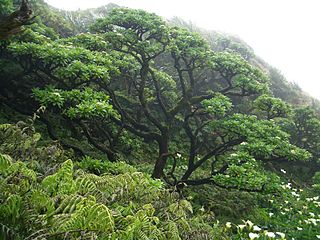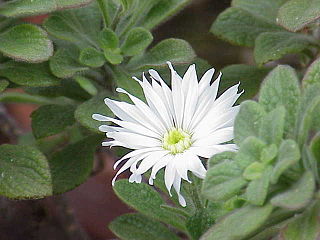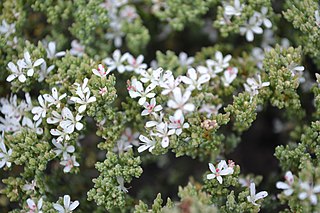
The Saint Helena earwig or Saint Helena giant earwig is an extinct species of very large earwig endemic to the oceanic island of Saint Helena in the south Atlantic Ocean.

The Saint Helena olive was a plant from the monotypic genus of flowering plants Nesiota within the family Rhamnaceae.

Melanodendron integrifolium is one of the endemic trees in the family Asteraceae from the island of Saint Helena. It is related to the Saint Helenan gumwoods and is the commonest of the remaining cabbage tree species of Saint Helena, although it is considered endangered due to the restricted population size.

Acalypha rubrinervis is an extinct plant in the spurge family (Euphorbiaceae), from the island of Saint Helena in the South Atlantic Ocean. It was called string tree on account of the thin pendulous inflorescences which resembled red strings. Disturbance following human settlement on the island destroyed its habitat and it was last seen in the 19th century. It is thus one of a number of island plants to have been driven to extinction by human activity.

The flora of Saint Helena, an isolated island in the South Atlantic Ocean, is exceptional in its high level of endemism and the severe threats facing the survival of the flora. In phytogeography, it is in the phytochorion St. Helena and Ascension Region of the African Subkingdom, in the Paleotropical Kingdom.

Trochetiopsis erythroxylon, the Saint Helena redwood, is a species of plant, now extinct in the wild. It was formerly abundant enough in the upland parts of the island of Saint Helena for early settlers in the 17th century to use the timber to make their homes. It now exists in cultivation, although cultivated stock is weak. This species has pendant flowers, petals that turn pink with age, and white staminodes.

Trochetiopsis ebenus, the dwarf ebony or Saint Helena ebony, is a species of flowering plant that is endemic to the island of Saint Helena in the southern Atlantic Ocean. It is not related to the ebony of commerce, but is instead a member of the mallow family, Malvaceae. Saint Helena ebony is now critically endangered in the wild, being reduced to two wild individuals on a cliff, but old roots are sometimes found washed out of eroding slopes. These are collected on the island a used for inlay work, an important craft on Saint Helena. A related species, Trochetiopsis melanoxylon is now completely extinct.

The Saint Helena plover, locally known as the wirebird due to its thin legs, is a small wader endemic to the island of Saint Helena in the mid-Atlantic. The bird is similar in appearance to the Kittlitz's plover of sub-Saharan Africa, but is rather larger. It is the national bird of St Helena and has been depicted on the country's coins. Populations in general have been declining. Threats include predation by cats, the introduction of the common myna, deforestation, off-road vehicle use, the Saint Helena Airport and a projected windfarm. In 2016, the population had recovered to about 560 mature individuals, from a previous minimum of less than 200 in 2006; consequently, the species was downlisted to Vulnerable from its previous assessment of Critically Endangered.

The Saint Helena cuckoo is an extinct bird. It was confirmed to have previously existed by a single humerus. Compared to other cuckoos, it was relatively small, and it probably lived in forests on the island of Saint Helena. Its extinction was a result of deforestation on the island in the 18th century.

Commidendrum rugosum, known as Scrubwood, is a species of flowering plant in the family Asteraceae.

Commidendrum spurium, the false gumwood, is a species of flowering plant in the family Asteraceae. It is found only in Saint Helena. Its natural habitats are subtropical or tropical moist lowland forests, rocky areas, and rocky shores. It is threatened by habitat loss.
Sium burchellii, known commonly as dwarf jellico, is a species of flowering plant in the family Apiaceae. It is endemic to Saint Helena. It grows on steep island cliffs. It is threatened by the fragmentation of its small populations, introduced species of plants, landslides, and possibly hybridization with Sium bracteatum.
Phylica polifolia, also called rosemary or Saint Helena rosemary, is a species of plant in the family Rhamnaceae. It is endemic to Saint Helena. Its natural habitats are rocky areas and rocky shores.

Wahlenbergia angustifolia, also called small bellflower, is a species of plant in the family Campanulaceae. It is endemic to Saint Helena. Its natural habitat is rocky areas. It is endangered because of habitat loss.

Wahlenbergia linifolia, the large bellflower, is a species of plant in the family Campanulaceae. It is endemic to Saint Helena. Its natural habitat is rocky areas. It is threatened by habitat loss.

Prosperous Bay Plain is an area on the eastern coast of Saint Helena, a British island territory in the South Atlantic Ocean. It is the site of the new Saint Helena Airport, and is notable for its high invertebrate biodiversity.

Frankenia pauciflora, the common sea-heath or southern sea-heath, is an evergreen shrub native to southern Australia. It is part of the Frankenia genus of the Frankeniaceae family.

Frankenia is the only genus in the Frankeniaceae family of flowering plants. Other genera have been recognized within the family, such as Anthobryum, Hypericopsis and Niederleinia, but molecular phylogenetic studies have consistently shown that they all belong inside Frankenia. Frankenia comprises about 70–80 species of shrubs, subshrubs and herbaceous plants, adapted to saline and dry environments throughout temperate and subtropical regions. A few species are in cultivation as ornamental plants.

Cap Island Conservation Park is a protected area in the Australian state of South Australia located about 7.5 kilometres (4.7 mi) offshore, west of Mount Misery, Eyre Peninsula. The park covers Cap Island's 8ha surface. The island consists of a granite base and a calcarenite mantle; its margins steeply over-hanging and eroded. Typical vegetation is a low Nitre Bush shrubland. Cap Island Conservation Park was constituted by statute in 1972 to conserve a sea bird breeding area and Australian Sea-lion and New Zealand Fur-seal haul-out areas.

















